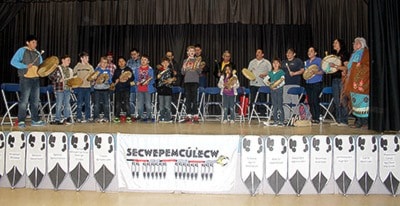Monday, April 7, was a day of recognition in School District 73, an initiative that acknowledges the Secwepemc and Nlaka’ Pamux Nations, their traditional territories and histories.
It is the first in what is hoped to be an annual event and will be marked by the hosting of assemblies in all district schools. The assemblies focused on recognizing the traditional territories of the Secwepemc and Nlaka’ Pamux peoples.
“It’s part of a bigger Aboriginal Education initiative that spans Kindergarten to Grade 12 and includes the history of the Nations and their traditional practices,” said Cheryl Sebastian, district principal, Aboriginal education. “The Day of Sucwentwecw (suk-went-wa) is a day to celebrate and acknowledge one another.”
Each school had the opportunity to invite an elder or representative from the Secwepemc or Nlak’ Pamuk community to be part of its assembly.
“The majority of schools in this district are on Secwepemc traditional territory,” said Renee Spence, administrator for the First Nations Education Council. “This day is intended to increase awareness and an appreciation for the traditional territory of the First Peoples in our area.”
Simpcw First Nation representatives and Simpcw Drummers took part in the assembly at Barriere Elementary School, which included students from Barriere Secondary as guests. They were the only schools in SD 73 that combined the event.
Simpcw Councillor and Drummer, Shelley Loring, introduced herself to the Barriere students, saying, “My Indian name is ‘Speaks For The People’... Simpcw means, ‘People Of The River’. We are a member of the 17 bands in the Secwepemc Nation, which originally had 32, but 15 bands are now extinct.”
Loring explained that the bands became extinct from diseases such as smallpox, and that at one time the Simpcw were also very close to extinction with just six people in the early 1900’s. “Now we are about 750 members strong and are still growing,” said Loring. “We were known as very fierce warriors who would defend our territory to the death, and we were also known as strong hunters and fisherman... and the Simpcw has the largest traditional territory of all the Secwepemc bands.”
Barriere Secondary aboriginal students Karina Eustache and Serena Steele presented a speech on what it means to be Secwepemc.
“Being Secwepemc means to be connected. Being connected to my family, my culture, my community, and also to myself. It’s more than just the colour of your skin, or where you live. It’s the qualities that you possess. It means to embrace the past and look forward to the future. Being aboriginal is to be proud of who you are, and what you stand for; no matter what you have been through... From residential schools, to discrimination; we’ve had many hard times, but things are now better than they’ve ever been. When I go to a Pow Wow I see so many aboriginal youth who are singing and dancing; being more actively involved in our culture, and getting closer to other community members. I see people being a bigger part of their families lives, and caring more for their communities and the members in it. People who aren’t afraid to be who they are. I am proud to be one of these people. I am proud to be Secwepemc, especially at those times when I can always be sure that I have someone to talk to, or laugh with, or even just sing.... It fills my heart. Another thing that I love is our youth group giving us so many opportunities... Showing us how to earn what we want, that not everything will just be handed to us on a silver platter. .. I know that we are not perfect...nobody is perfect. But the important thing is that we are progressing. And truly, in the end, if we are to have nothing, the few things that we should be able to count on to always be there is our community, our families, our culture, and most of all ourselves. For without these things... we would be without progress, we would be stuck in the past, unable to write our own future.”
